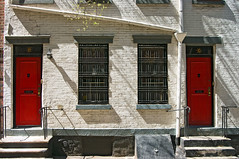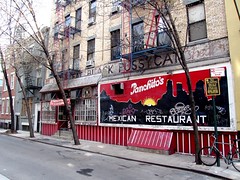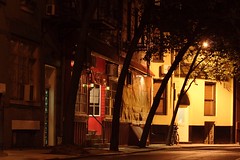West:
Corner (25 Minetta Lane): A five-story building
from 1940 that destroyed a charming 1924 redevelopment
by Vincent Pepe.
12-14: A three- story building here is the only building on this side of the street that dates back before the mid-20th Century. (290 6th Ave): A six-story building from 1941, designed by H.I. Feldman. Minetta Triangle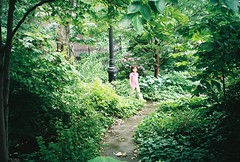 A very nice, very little (0.075 acres)
park--worth stopping in. A scrap left over from the expansion
of 6th Avenue in 1925, it was given to the Parks Department
in 1945. Refurbished in 1998, the images of trout recall
Minetta Brook, now underground, which is the ultimate
source of the park's name.
A very nice, very little (0.075 acres)
park--worth stopping in. A scrap left over from the expansion
of 6th Avenue in 1925, it was given to the Parks Department
in 1945. Refurbished in 1998, the images of trout recall
Minetta Brook, now underground, which is the ultimate
source of the park's name.
|
M
I
N
E
T
T
A
S
T
R
E
E
T
East: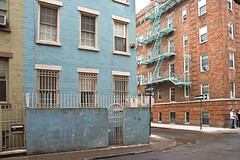
Corner (5 Minetta Lane): A four-story building
put up by builder
David Louderback in 1840.
A short wall protects a few
square feet of front yard. Vincent Pepe bought
and two adjacent houses in 1924 and turned
them into studio apartments
with a common rear garden. Pepe committed suicide
in 1935 after being accused the year before of ripping off an
investor.
19: Dates back to the 1840s; has a sweet little courtyard. 17: Three stories also put up in 1840 by builder
David Louderback, then redeveloped into studio apartments
by Vincent Pepe. There's a modern glass-and-steel rear
facade.
11-13: Was the Fat Black Pussycat,
where Bob Dylan wrote "Blowing in the Wind"; its faded sign is
still visible. Now the restaurant Pepito's, whose main
entrance is
103 Macdougal.
9: Minetta Street Suites, a tiny hotel at the bend of Minetta Street. 5-7: Used in the movie Serpico as the apartment of the whistle-blowing cop. No. 7 is the building in the rear of the lot, built 1905. Corner (203 Bleecker): Corporate clothing outlet. |

